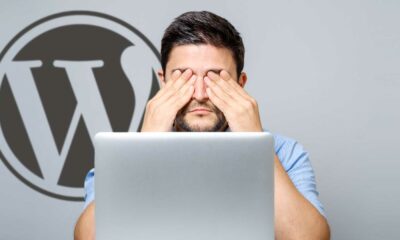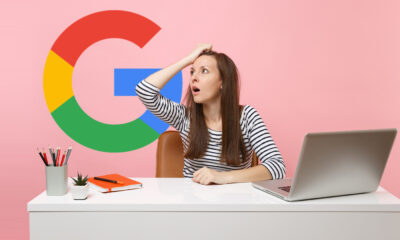SEO
Google’s Preferred Structured Data: JSON-LD vs. Microdata

Google uses structured data to better understand what a webpage is about by classifying the topic, identifying important parts of the webpages like logos and images, and displaying webpages prominently at the top of the page.
There are multiple kinds of structured data, but only one of them is preferred by Google, so it’s important to use the right format.
Which Types Of Structured Data Does Google Support?
Google supports three kinds of structured data:
- JSON-LD.
- Microdata.
- RDFa.
Each of those standards is a different way of communicating structured data and is specified on the official Schema.org website.

In the image above, it can be seen that the Schema.org structured data example provides examples in three formats.
There are three tabs. Each tab corresponds to a different form of structured data: Microdata, RDFa, and JSON-LD structured data.
What Is Microdata Structured Data?
Microdata is a way to add metadata within the HTML code and is a part of the HTML specification, also known as the WHATWG (Web Hypertext Application Technology Working Group) HTML standard.
Microdata is an HTML specification for marking up a webpage within the HTML itself.
It is essentially metadata that is placed within the HTML code that is published within the <body> tags and is readable by machines like Googlebot.
Schema.org, the non-profit organization that creates the structured data specifications, published a structured data explainer called Getting Started and used Microdata in all of their examples.
So, Microdata is still a valid way to communicate structured data and is currently supported by the Schema.org standards-making body as well as by Google (except in specific cases where it is explicitly not supported).
The microdata is nested within existing HTML like this:
<body itemscope itemtype="https://schema.org/WebPage"> <div itemprop="breadcrumb"> <a href="https://www.searchenginejournal.com/structured-data-google-prefers/451847/category/books.html">Books</a> <a href="category/books-literature.html">Literature & Fiction</a> > <a href="category/books-classics">Classics</a> </div>
In the above code, the microdata called, “itemprop” is inserted to specify the structured data Property, in this case, the breadcrumb structured data property.
This is what that code looks like without the microdata structured data:
<div>
<a href=”category/books.html”>Books</a>
<a href=”category/books-literature.html”>Literature & Fiction</a>
<a href=”category/books-classics”>Classics</a>
</div>
There are other ways of doing the same thing by using the BreadcrumbList structured data type as well.
What Is RDFa Structured Data?
RDFa is an acronym for Resource Description Framework in attributes. It is an extension of HTML.
The reason it’s called an extension of HTML is that it extends HTML.
Google describes RDFa like this:
“Microformats specify both a syntax for including structured data into HTML documents and set of microformat classes each with its own specific vocabulary of allowed attributes.
RDFa, on the other hand, specifies only a syntax and allows you to use existing vocabularies of attributes or create your own.
It even lets you combine multiple vocabularies freely. If the existing vocabularies do not meet your needs, you can define your own standards and vocabularies by creating new fields.”
RDFa offers an additional way of communicating structured data to Google that is less intrusive to the code than the microdata method.
Like microdata, RDFa is currently specified as a valid form of data by Schema.org and is currently supported by Google (except when explicitly not specified).
This is what a breadcrumb structured data can look like in the RDFa format:
<body itemscope itemtype=”https://schema.org/WebPage”>
<div itemprop=”breadcrumb”>
<a href=”category/books.html”>Books</a> >
<a href=”category/books-literature.html”>Literature & Fiction</a> >
<a href=”category/books-classics”>Classics</a>
</div>
What Is JSON-LD?
JSON-LD is a scripting language that allows publishers to communicate important information to search engines.
JSON-LD is an acronym for JavaScript Object Notation for Linked Data.
Because it’s a script, it’s relatively easier to use than Microdata and RDFa because JSON-LD is not embedded within the HTML as metadata or as an extension of the HTML itself.
JSON-LD can be placed anywhere on a webpage, even in the Head section of the webpage code which is where metadata usually goes.
JSON-LD can also be placed at the end of the code or within the content section of the code (it will not be visible to site visitors).
Another benefit of JSON-LD is that, because it’s separated from the HTML and exists within its own script, it can be easily edited and reviewed.
A breadcrumb list structured data markup can look like this:
<script type="application/ld+json">
{
"@context": "https://schema.org",
"@type": "BreadcrumbList",
"itemListElement": [{
"@type": "ListItem",
"position": 1,
"name": "Widgets",
"item": "https://example.com/widgets"
},{
"@type": "ListItem",
"position": 2,
"name": "Blue Widgets",
"item": "https://example.com/widgets/blue-widgets"
},{
"@type": "ListItem",
"position": 3,
"name": "Reviews"
}]
}
</script>
Troubleshooting a script that is completely separated from the HTML is so much easier than trying to code the structured data within the HTML, which is how Microdata and RDFa are done.
According to the official JSON-LD website:
“Data is messy and disconnected. JSON-LD organizes and connects it, creating a better Web.
It is a way to create a network of standards-based, machine-readable data across Web sites.”
JSON-LD scripts can be added to a webpage in a manner that can be templated within a website, making it easy to add, update, and remove.
The official Schema.org structured data specification can be found at Schema.org (surprise!).
Which Type Of Structured Data Does Google Prefer?
Even though Microdata continues to be supported by the Schema.org standards-making organization, what matters is the version that Google supports.
In a Google Office-hours hangout from March 2019, a participant asked the following question:
“What type of Schema markup is preferable for Google? Should I use Jason or… microformats? Which format is preferable?”
John Mueller answered:
“We currently prefer JSON-LD markup. I think most of the new structured data that are kind of come out for JSON-LD first. So that’s what we prefer.”
Google Prefers JSON-LD Structured Data
Google’s John Mueller made it clear that Google preferred JSON-LD structured data.
A benefit of JSON-LD structured data is that it is non-intrusive.
It’s non-intrusive because it keeps structured data separate from the HTML code.
That makes reading, troubleshooting, and updating structured data so much easier because it’s more simple to implement and maintain.
Additionally, the JSON-LD scripting language follows a set of easily learned rules and can easily be added or removed from a site.
How To Implement JSON-LD Structured Data
The official Schema.org JSON-LD structured data Schema.org website has many examples of how to write the structured data code. Just take an example and use it as a template.
Here’s an image of an example without structured data:
 Screenshot by author, May 2022
Screenshot by author, May 2022
This is an example of the exact same content expressed as JSON-LD Schema.org structured data:
 Screenshot by author, May 2022
Screenshot by author, May 2022
Google Prefers JSON-LD Structured Data
Google’s preferred format for structured data is JSON-LD.
Because that’s Google’s preference, it’s a good idea to make sure that all structured data used within a webpage is using JSON-LD and not the JSON-LD structure.
Watch the Google Webmaster Office-hours hangout at the 22:33 minute mark:
More Resources:
Featured Image: Helder Almeida/Shutterstock
!function(f,b,e,v,n,t,s)
{if(f.fbq)return;n=f.fbq=function(){n.callMethod?
n.callMethod.apply(n,arguments):n.queue.push(arguments)};
if(!f._fbq)f._fbq=n;n.push=n;n.loaded=!0;n.version=’2.0′;
n.queue=[];t=b.createElement(e);t.async=!0;
t.src=v;s=b.getElementsByTagName(e)[0];
s.parentNode.insertBefore(t,s)}(window,document,’script’,
‘https://connect.facebook.net/en_US/fbevents.js’);
if( typeof sopp !== “undefined” && sopp === ‘yes’ ){
fbq(‘dataProcessingOptions’, [‘LDU’], 1, 1000);
}else{
fbq(‘dataProcessingOptions’, []);
}
fbq(‘init’, ‘1321385257908563’);
fbq(‘track’, ‘PageView’);
fbq(‘trackSingle’, ‘1321385257908563’, ‘ViewContent’, {
content_name: ‘structured-data-google-prefers’,
content_category: ‘seo technical-seo’
});
SEO
Google March 2024 Core Update Officially Completed A Week Ago

Google has officially completed its March 2024 Core Update, ending over a month of ranking volatility across the web.
However, Google didn’t confirm the rollout’s conclusion on its data anomaly page until April 26—a whole week after the update was completed on April 19.
Many in the SEO community had been speculating for days about whether the turbulent update had wrapped up.
The delayed transparency exemplifies Google’s communication issues with publishers and the need for clarity during core updates
Google March 2024 Core Update Timeline & Status
First announced on March 5, the core algorithm update is complete as of April 19. It took 45 days to complete.
Unlike more routine core refreshes, Google warned this one was more complex.
Google’s documentation reads:
“As this is a complex update, the rollout may take up to a month. It’s likely there will be more fluctuations in rankings than with a regular core update, as different systems get fully updated and reinforce each other.”
The aftershocks were tangible, with some websites reporting losses of over 60% of their organic search traffic, according to data from industry observers.
The ripple effects also led to the deindexing of hundreds of sites that were allegedly violating Google’s guidelines.
Addressing Manipulation Attempts
In its official guidance, Google highlighted the criteria it looks for when targeting link spam and manipulation attempts:
- Creating “low-value content” purely to garner manipulative links and inflate rankings.
- Links intended to boost sites’ rankings artificially, including manipulative outgoing links.
- The “repurposing” of expired domains with radically different content to game search visibility.
The updated guidelines warn:
“Any links that are intended to manipulate rankings in Google Search results may be considered link spam. This includes any behavior that manipulates links to your site or outgoing links from your site.”
John Mueller, a Search Advocate at Google, responded to the turbulence by advising publishers not to make rash changes while the core update was ongoing.
However, he suggested sites could proactively fix issues like unnatural paid links.
“If you have noticed things that are worth improving on your site, I’d go ahead and get things done. The idea is not to make changes just for search engines, right? Your users will be happy if you can make things better even if search engines haven’t updated their view of your site yet.”
Emphasizing Quality Over Links
The core update made notable changes to how Google ranks websites.
Most significantly, Google reduced the importance of links in determining a website’s ranking.
In contrast to the description of links as “an important factor in determining relevancy,” Google’s updated spam policies stripped away the “important” designation, simply calling links “a factor.”
This change aligns with Google’s Gary Illyes’ statements that links aren’t among the top three most influential ranking signals.
Instead, Google is giving more weight to quality, credibility, and substantive content.
Consequently, long-running campaigns favoring low-quality link acquisition and keyword optimizations have been demoted.
With the update complete, SEOs and publishers are left to audit their strategies and websites to ensure alignment with Google’s new perspective on ranking.
Core Update Feedback
Google has opened a ranking feedback form related to this core update.
You can use this form until May 31 to provide feedback to Google’s Search team about any issues noticed after the core update.
While the feedback provided won’t be used to make changes for specific queries or websites, Google says it may help inform general improvements to its search ranking systems for future updates.
Google also updated its help documentation on “Debugging drops in Google Search traffic” to help people understand ranking changes after a core update.
Featured Image: Rohit-Tripathi/Shutterstock
FAQ
After the update, what steps should websites take to align with Google’s new ranking criteria?
After Google’s March 2024 Core Update, websites should:
- Improve the quality, trustworthiness, and depth of their website content.
- Stop heavily focusing on getting as many links as possible and prioritize relevant, high-quality links instead.
- Fix any shady or spam-like SEO tactics on their sites.
- Carefully review their SEO strategies to ensure they follow Google’s new guidelines.
SEO
Google Declares It The “Gemini Era” As Revenue Grows 15%

Alphabet Inc., Google’s parent company, announced its first quarter 2024 financial results today.
While Google reported double-digit growth in key revenue areas, the focus was on its AI developments, dubbed the “Gemini era” by CEO Sundar Pichai.
The Numbers: 15% Revenue Growth, Operating Margins Expand
Alphabet reported Q1 revenues of $80.5 billion, a 15% increase year-over-year, exceeding Wall Street’s projections.
Net income was $23.7 billion, with diluted earnings per share of $1.89. Operating margins expanded to 32%, up from 25% in the prior year.
Ruth Porat, Alphabet’s President and CFO, stated:
“Our strong financial results reflect revenue strength across the company and ongoing efforts to durably reengineer our cost base.”
Google’s core advertising units, such as Search and YouTube, drove growth. Google advertising revenues hit $61.7 billion for the quarter.
The Cloud division also maintained momentum, with revenues of $9.6 billion, up 28% year-over-year.
Pichai highlighted that YouTube and Cloud are expected to exit 2024 at a combined $100 billion annual revenue run rate.
Generative AI Integration in Search
Google experimented with AI-powered features in Search Labs before recently introducing AI overviews into the main search results page.
Regarding the gradual rollout, Pichai states:
“We are being measured in how we do this, focusing on areas where gen AI can improve the Search experience, while also prioritizing traffic to websites and merchants.”
Pichai reports that Google’s generative AI features have answered over a billion queries already:
“We’ve already served billions of queries with our generative AI features. It’s enabling people to access new information, to ask questions in new ways, and to ask more complex questions.”
Google reports increased Search usage and user satisfaction among those interacting with the new AI overview results.
The company also highlighted its “Circle to Search” feature on Android, which allows users to circle objects on their screen or in videos to get instant AI-powered answers via Google Lens.
Reorganizing For The “Gemini Era”
As part of the AI roadmap, Alphabet is consolidating all teams building AI models under the Google DeepMind umbrella.
Pichai revealed that, through hardware and software improvements, the company has reduced machine costs associated with its generative AI search results by 80% over the past year.
He states:
“Our data centers are some of the most high-performing, secure, reliable and efficient in the world. We’ve developed new AI models and algorithms that are more than one hundred times more efficient than they were 18 months ago.
How Will Google Make Money With AI?
Alphabet sees opportunities to monetize AI through its advertising products, Cloud offerings, and subscription services.
Google is integrating Gemini into ad products like Performance Max. The company’s Cloud division is bringing “the best of Google AI” to enterprise customers worldwide.
Google One, the company’s subscription service, surpassed 100 million paid subscribers in Q1 and introduced a new premium plan featuring advanced generative AI capabilities powered by Gemini models.
Future Outlook
Pichai outlined six key advantages positioning Alphabet to lead the “next wave of AI innovation”:
- Research leadership in AI breakthroughs like the multimodal Gemini model
- Robust AI infrastructure and custom TPU chips
- Integrating generative AI into Search to enhance the user experience
- A global product footprint reaching billions
- Streamlined teams and improved execution velocity
- Multiple revenue streams to monetize AI through advertising and cloud
With upcoming events like Google I/O and Google Marketing Live, the company is expected to share further updates on its AI initiatives and product roadmap.
Featured Image: Sergei Elagin/Shutterstock
SEO
brightonSEO Live Blog

Hello everyone. It’s April again, so I’m back in Brighton for another two days of Being the introvert I am, my idea of fun isn’t hanging around our booth all day explaining we’ve run out of t-shirts (seriously, you need to be fast if you want swag!). So I decided to do something useful and live-blog the event instead.
Follow below for talk takeaways and (very) mildly humorous commentary. sun, sea, and SEO!
-
SEARCHENGINES7 days ago
Daily Search Forum Recap: April 19, 2024
-

 WORDPRESS6 days ago
WORDPRESS6 days ago13 Best HubSpot Alternatives for 2024 (Free + Paid)
-

 WORDPRESS7 days ago
WORDPRESS7 days ago7 Best WooCommerce Points and Rewards Plugins (Free & Paid)
-

 MARKETING7 days ago
MARKETING7 days agoBattling for Attention in the 2024 Election Year Media Frenzy
-

 MARKETING6 days ago
MARKETING6 days agoAdvertising in local markets: A playbook for success
-

 SEO7 days ago
SEO7 days agoGoogle Answers Whether Having Two Sites Affects Rankings
-

 SEARCHENGINES6 days ago
SEARCHENGINES6 days agoGoogle Core Update Flux, AdSense Ad Intent, California Link Tax & More
-

 AFFILIATE MARKETING6 days ago
AFFILIATE MARKETING6 days agoGrab Microsoft Project Professional 2021 for $20 During This Flash Sale


![The Current State of Google’s Search Generative Experience [What It Means for SEO in 2024] person typing on laptop with](https://articles.entireweb.com/wp-content/uploads/2024/04/The-Current-State-of-Googles-Search-Generative-Experience-What-It.webp-400x240.webp)
![The Current State of Google’s Search Generative Experience [What It Means for SEO in 2024] person typing on laptop with](https://articles.entireweb.com/wp-content/uploads/2024/04/The-Current-State-of-Googles-Search-Generative-Experience-What-It.webp-80x80.webp)












You must be logged in to post a comment Login